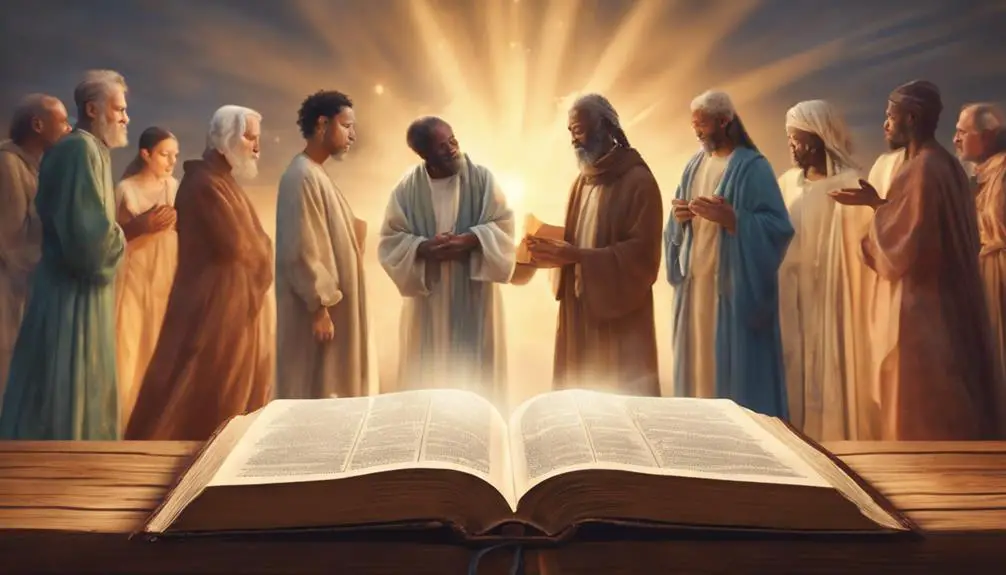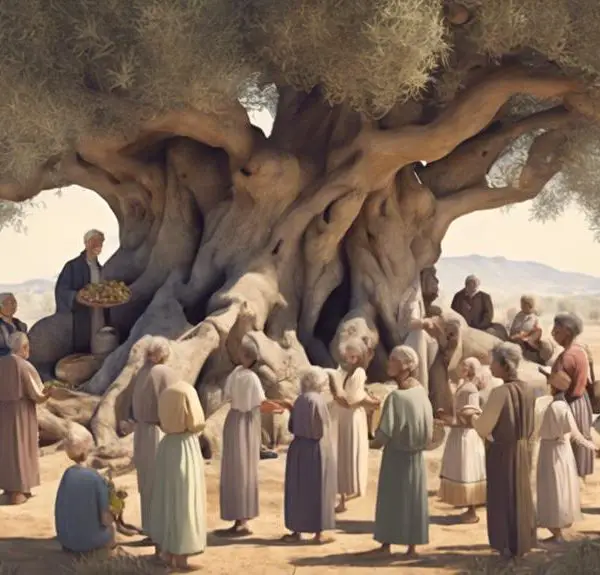Learn how the Bible's depiction of divine splendor reveals God's power, love, and grace, inviting us into a deeper faith journey.

Splendor Meaning in the Bible
You might think the concept of 'splendor' in the Bible is too abstract or elusive to grasp fully, but it's actually central to understanding the divine.
The Bible paints vivid pictures of God's splendor, from the majesty of creation to the promise of eternal glory. This splendor isn't just about visual beauty; it's a reflection of God's power, love, and grace.
As we explore the various dimensions of divine splendor, you'll discover how it shapes our understanding of God, our responses to Him, and the incredible promises He has for us.
What does this mean for your personal journey of faith? Let's explore this together and uncover the profound implications of divine splendor in your life.
Key Takeaways
- Divine splendor in the Bible symbolizes God's unmatched glory and majestic presence.
- Splendor manifests in creation, showcasing God's power, creativity, and attention to detail.
- Biblical narratives reveal splendor through ceremonial worship and the profound mystery of encountering the divine.
- Eternal splendor promises an everlasting joy and inheritance, emphasizing spiritual over material pursuits.
The Essence of Divine Splendor

The essence of divine splendor in the Bible encapsulates God's unparalleled glory and majesty, reflecting His supreme power and presence throughout the scriptures. This splendor, while profoundly significant, remains shrouded in mystery due to the divine invisibility that characterizes God's essence. You can't physically see or grasp the fullness of His majesty, yet it's undeniably present and felt. This paradox lies at the heart of understanding divine splendor—it's both revealed and hidden, known and unknowable.
Analyzing the scriptures, you'll find that God's splendor transcends human understanding. It's not merely an aesthetic beauty but a manifestation of His holiness and otherness. The Bible speaks of God dwelling in unapproachable light, a metaphor highlighting the gap between human perception and divine reality. This divine invisibility doesn't diminish His splendor but rather enhances its mystery and allure. It invites you to seek a deeper, more profound connection with the divine, beyond what eyes can see.
Thus, the essence of divine splendor in the Bible isn't just about acknowledging God's greatness; it's about engaging with the mystery of His presence. Despite His invisibility, God's splendor permeates everything, offering glimpses of His glory to those who seek Him with a sincere heart.
Splendor in Creation

Exploring the splendor in creation reveals God's intricate craftsmanship and divine artistry, inviting you to witness His glory manifest in the natural world. This exploration uncovers not just the beauty of the universe but also the intentional design behind its creation, showcasing God's omnipotence and love for diversity. Through the lens of the Bible, the cosmic beauty and artistic expressions found in creation serve as a testament to God's majesty and creativity.
Consider these aspects of creation's splendor:
- The Vastness of the Universe: The sheer scale of the cosmos, with its billions of galaxies and stars, reflects the boundless nature of God's creativity and power.
- Complexity of Life: From the intricate DNA code that shapes life to the diverse ecosystems supporting myriad species, life's complexity points to a Creator with an eye for detail and an appreciation for variety.
- Seasonal Changes: The rhythmic patterns of seasons demonstrate God's provision and foresight, ensuring the sustenance and renewal of life through a balance of growth and rest periods.
Analyzing these elements, it's evident that creation's splendor isn't just a display of cosmic beauty but also a reflection of God's artistic expressions, revealing His character and intentions.
Manifestations of Splendor

Having considered the splendor in creation as a reflection of God's majesty, we now turn our attention to the varied manifestations of splendor throughout the biblical narrative, revealing deeper insights into the divine character and the sacred. These manifestations aren't merely aesthetic; they embody the splendor attributes of God's nature—His holiness, sovereignty, and omnipotence.
In the context of ceremonial splendor, the Bible is replete with instances where divine splendor is woven into rituals and worship practices, underscoring a deep respect for the sacred. The intricate details of the Tabernacle, the priestly garments, and the solemn rites performed therein, all reflect a tangible manifestation of splendor, designed to invoke reverence and awe.
This ceremonial splendor isn't just for grandeur's sake; it serves as a conduit through which believers can engage with the divine. It underscores the meticulous care with which God's presence is to be approached and the profound reverence His holiness demands. Through these rich, symbolic expressions of splendor, the Bible conveys that encountering the divine is an experience of both overwhelming beauty and profound mystery, inviting believers to reflect on the magnitude of God's majesty.
Human Response to Splendor

Human beings often find themselves awestruck by the splendor revealed in the biblical narrative, responding with a mix of reverence, worship, and sometimes, transformative introspection. This reaction underscores the profound impact that divine majesty can have on the human spirit.
However, the human response to splendor isn't uniform and can be analyzed through several lenses:
- Splendor Perception: Individuals interpret splendor through their personal, cultural, and spiritual lenses. This variance in perception shapes the depth and nature of their response.
- Awe Limitations: While splendor can evoke profound awe, human beings are often limited in their capacity to fully comprehend or retain the intensity of these experiences over time.
- Transformative Action: For some, the encounter with splendor leads to transformative actions or decisions, driven by a desire to align more closely with the observed divine attributes.
These responses highlight the complexity of human engagement with biblical splendor. They reflect an interplay between immediate emotional reactions and longer-term spiritual and ethical transformations. Understanding this dynamic offers insights into the ways in which divine splendor can influence human thought, behavior, and spirituality, despite inherent limitations in human capacity for awe.
Promises of Eternal Splendor

While the human response to splendor varies greatly, the Bible also offers a vision of eternal splendor that promises a future beyond our current understanding or experience. This vision presents a profound contrast between the temporal and the eternal, highlighting the fleeting nature of earthly splendor in comparison to the everlasting splendor rewards promised to believers.
Temporal Contrasts |
Eternal Splendor Rewards |
|---|---|
Earthly riches fade |
Unfading inheritance |
Momentary pleasures |
Everlasting joy |
Physical beauty withers |
Incorruptible beauty |
Human glory is transient |
Unending divine glory |
Mortal power is limited |
Infinite divine power |
This table succinctly encapsulates the stark differences between the transient nature of earthly splendors and the promised eternal splendor in the afterlife. Analytically, one can discern that the Bible not only seeks to direct the believer's gaze away from the fleeting, but also to instill a deep yearning for that which is everlasting. Insightfully, this comparison serves as a reminder that the splendor rewards of eternity far surpass anything imaginable in our temporal existence, emphasizing the importance of spiritual pursuits over material ones.
Frequently Asked Questions
How Do Different Bible Translations Vary in Their Use of the Word "Splendor" and What Implications Does This Have for Understanding Biblical Texts?
Different Bible translations employ varied approaches to the word 'splendor', influenced by translation methodology and lexical semantics. This variation affects your understanding of biblical texts, as each translation might convey a slightly different nuance or emphasis.
It's crucial to consider the translator's choices and the underlying theology that guides these decisions. Analyzing these differences can offer you deeper insights into the text's original meaning and its implications for contemporary interpretation.
Can the Concept of Divine Splendor Be Found in Other Religious Texts Outside of the Bible, and if So, How Are They Similar or Different?
You'll find the concept of divine splendor in various religious texts, each offering unique insights into divine aesthetics. Splendor symbolism often conveys the majesty and beauty of the divine, highlighting differences and similarities across traditions.
For instance, in Hindu texts, the splendor of gods reflects their power and virtues, whereas in Islamic scriptures, divine splendor emphasizes omnipresence and omniscience, enriching your understanding of how divinity is portrayed across cultures.
Are There Any Historical or Cultural Contexts in Ancient Times That Influenced the Biblical Authors' References to Splendor?
Absolutely, ancient aesthetics and cultural symbolism heavily influenced how splendor was conceptualized by biblical authors.
You'll find that their references to splendor weren't created in a vacuum but were shaped by the rich tapestry of their surroundings.
From the grandeur of nature to the opulence of contemporary empires, these elements seeped into their writings, offering us a window into the ancient world's view on beauty and divine magnificence.
How Has the Interpretation of Biblical Splendor Influenced Christian Art and Architecture Throughout History?
You'll find that throughout history, the interpretation of splendor has deeply influenced Christian art and architecture. Artists and architects have drawn on splendor symbolism to convey divine glory and heavenly realms using various artistic mediums. This approach has shaped the aesthetic and thematic elements of churches, paintings, and sculptures, embedding a rich layer of spiritual meaning.
It's a testament to how interpretations can transform artistic expression, enriching both faith and culture.
In What Ways Do Modern Theologians and Scholars Debate or Reinterpret the Concept of Splendor in the Bible?
Modern theologians and scholars actively debate and reinterpret splendor in the Bible, focusing on its symbolism and contemporary relevance. They're delving into how its representation can inform current faith practices and societal views.
You'll find them analyzing the text to uncover deeper meanings, questioning traditional interpretations, and proposing new perspectives that resonate with today's believers. This dynamic discussion enriches understanding, bridging ancient concepts with modern spiritual and ethical considerations.
Conclusion
In conclusion, you've explored the multifaceted concept of divine splendor within the biblical context, revealing its essence, manifestations in creation, and the human response it evokes. This exploration underscores that splendor isn't merely aesthetic; it's deeply theological, reflecting God's glory, inviting human admiration, and promising eternal splendor.
Through this analysis, it's clear that splendor serves as a bridge between the divine and the human, offering glimpses of eternal beauty and hope amidst the transient.



Sign up